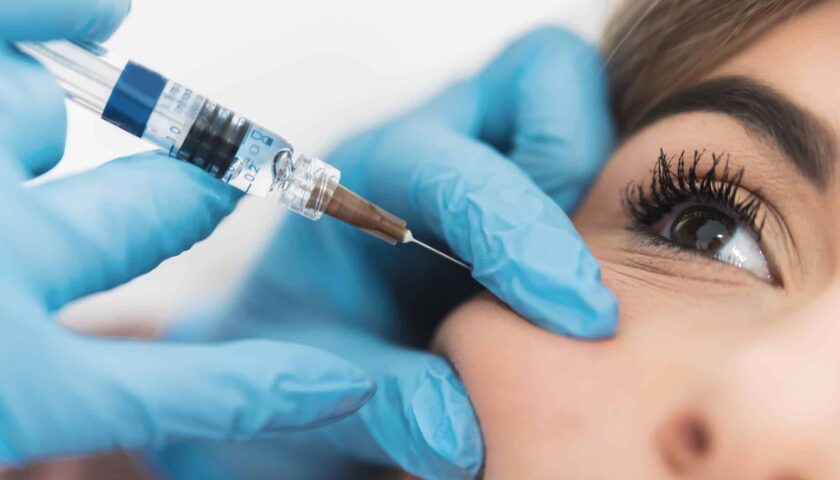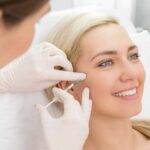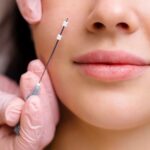
Cheek fillers are injectable substances used to augment and enhance the appearance of the cheeks. They are a popular beauty procedure, as they improve facial appearance, restore volume, and contour the midface.
Cheek fillers typically comprise hyaluronic acid, calcium hydroxylapatite, poly-L-lactic acid, or other biocompatible substances. These fillers are carefully injected into the targeted areas to restore volume, improve facial proportions, and achieve a more youthful appearance.
Understanding the intricacies of cheek fillers, including their longevity, is essential in providing patients with accurate information and effective treatment plans.
Factors Affecting Cheek Fillers Results
The duration of cheek filler effects can vary based on several factors, including filler characteristics and patient-related factors.
Filler Characteristics
- Composition: the specific properties of different fillers can influence their longevity. Hyaluronic acid fillers usually have a shorter lifespan; between 6 and 18 months, whereas calcium hydroxylapatite cheek fillers last up to 12 months or longer. Poly-L-lactic acid fillers stimulate collagen production, resulting in a gradual improvement that can last up to 2 years.
- The molecular weight and degree of cross-linking of fillers can affect their durability. Higher molecular weight and increased cross-linking lead to longer-lasting results.
- Viscosity: fillers with higher density provide longer-lasting outcomes due to their ability to resist degradation and maintain structural integrity.
- Enzymatic degradation. Fillers undergo enzymatic degradation. The body’s enzymes gradually break down the filler material, resulting in natural absorption. This rate varies depending on the type of filler used.
Patient Factors
- The metabolic rate of patients can impact the duration of filler results. Individuals with faster metabolism experience a more rapid breakdown and absorption of fillers, resulting in shorter-lasting effects.
- Lifestyle and Habits. Smoking, excessive sun exposure, and poor skincare routines can speed up filler degradation. Educating patients about healthy habits and proper skin care can help extend the duration of filler results.
- Individual facial anatomy and skin characteristics play a role in filler longevity. Factors like skin thickness, hydration levels, and natural collagen production can affect how quickly the body breaks down fillers.
- The body’s immune response can contribute to the breakdown and elimination of fillers. Inflammatory cells and processes play a role in the gradual absorption of the filler material.
Expected Duration of Different Cheek Fillers
Different cheek fillers have varying durations of effectiveness. Below summarizes the average duration of commonly used fillers:
- Hyaluronic acid fillers are temporary and typically last between 6 and 18 months. The specific product used, injection technique, and individual patient characteristics can influence the duration of the results.
- Calcium hydroxylapatite fillers provide longer-lasting results, lasting up to 12 months or even longer. The longevity of these dermal fillers can vary depending on factors such as product formulation, injection technique, and patient-related variables.
- Poly-L-lactic acid fillers stimulate collagen production, resulting in gradual and long-lasting improvements. The results of poly-L-lactic acid cheek fillers can last up to 2 years. However, it’s important to note that multiple treatment sessions are often necessary to achieve the desired outcome, and maintenance treatments may be required to sustain the results.
Despite now understanding the average duration of fillers, individual responses can vary. Some patients experience longer-lasting results than the average duration, while others metabolize fillers more quickly. Regular follow-up appointments help monitor the patient’s response and make any necessary adjustments to treatment plans.
Maintenance treatments can extend the longevity of cheek fillers. These treatments involve smaller doses of fillers to keep the desired results and address any natural aging changes or volume loss that may occur.
It is important to mention that aesthetic medicine is constantly evolving, with ongoing advances in filler technology. Newer formulations and techniques lead to improved longevity of results. Aesthetic professionals must stay informed about these advances through continued education, conferences, and research publications to offer their patients the most up-to-date treatment options.
Aftercare Tips for Prolonged Results
Proper aftercare is essential to make cheek fillers last longer. Following these aftercare tips can help optimize the longevity of dermal fillers and ensure the best outcomes:
- Follow post-treatment instructions. They include specific guidelines on activities to avoid immediately after the treatment, such as intense exercise, excessive facial movements, or exposure to extreme temperatures. Adhering to these instructions helps prevent complications and supports optimal healing.
- Gentle facial care. Avoid excessive touching, rubbing, or massaging of the treated areas, as this can disrupt the filler’s placement and potentially cause complications. When cleansing the face, choose mild, non-abrasive products that won’t irritate the skin.
- Regularly protect the skin from harmful sun exposure by applying a broad-spectrum sunscreen with a high SPF. UV radiation speeds up the breakdown of fillers and contributes to premature aging. Wearing a wide-brimmed hat and avoiding prolonged sun exposure can further protect the treated areas.
- Avoid certain procedures, such as laser treatments, chemical peels, or microdermabrasion, as they may affect the longevity of fillers or cause adverse reactions.
- Maintaining a healthy lifestyle contributes to better skin health and extends the longevity of cheek fillers. Some examples are staying hydrated, eating a nutritious diet rich in antioxidants, avoiding smoking, and excessive alcohol consumption.
Maintain open communication with your patients throughout the treatment process. Encourage them to report any unexpected side effects, changes, or concerns they may have, so that you can guide them and address any issues.
By following these aftercare tips and staying committed to skin health, your patients can maximize the effect of cheek fillers and enjoy the benefits of a refreshed and enhanced appearance for an extended period.
Conclusion
The answer to “How long do fillers last in cheeks?” isn’t as simple as it might look, as many factors influence the treatment’s longevity. Several factors, such as the type of filler used, the patient’s metabolic rate, lifestyle choices, skin condition, and their aging stage, will collectively influence the pace at which the cheeks return to their original appearance prior to the filler treatment.
To maximize the effects of treatments and assist patients in attaining their desired aesthetic outcomes, physicians should consider these factors, offer personalized aftercare guidance, and engage in open communication with their patients.
FAQ
Do cheeks go back to normal after filler?
Cheeks do not automatically return to their pre-filler state once the effects of the filler have worn off. While cheek fillers are temporary, the effects of cheek enhancement can still impact the natural aging process.
Fillers restore volume, improve the contours of the cheeks, and stimulate collagen production. This can slow down the rate of volume loss in the long term.
However, managing patient expectations and clarifying that maintenance treatments may be necessary to sustain the desired results is essential. By scheduling regular follow-up consultations with an aesthetic doctor, you’ll ensure your aesthetic results are continually evaluated and determine if extra injections are necessary to maintain your desired look.
Ultimately, the longevity of cheek fillers and the likelihood of the cheeks returning to their original state after the filler has dissipated will vary among individuals. Factors such as the type of filler used, individual metabolism, lifestyle habits, and the overall aging process will all play a role in determining the extent to which the cheeks revert to their pre-filler appearance.
What is the best age to get cheek fillers?
The optimal age to get cheek fillers will differ depending on individual factors, goals, and the natural aging process of each person. Experts agree that individuals in their mid to late twenties and thirties are an ideal age group to begin cheek filler treatments. They often perceive this age range as an opportune time to address early signs of volume loss and maintain youthful facial contours.
During this stage of life, individuals typically have a good baseline level of collagen and elastin, vital components of healthy and resilient skin. By introducing long-lasting cheek fillers at this age, it is possible to enhance facial features, restore subtle volume loss, and prevent more significant age-related changes from occurring in the future.
Starting cheek filler treatments in the mid to late twenties or thirties facilitates a more conservative approach, as the goal is often to maintain and enhance the face’s natural beauty rather than correcting significant volume loss. The treatment can provide subtle enhancements, restore youthful contours, and help maintain a fresh and vibrant appearance.
Beginning treatments at a younger age can have long-term benefits. Cheek fillers can effectively slow the aging process and prevent the significant loss of volume usually associated with aging by stimulating collagen production and preserving facial volume.
References
Trinh, L. N., & Gupta, A. (2021). Hyaluronic Acid Fillers for Midface Augmentation: A Systematic Review. Facial plastic surgery: FPS, 37(5), 576–584. https://doi.org/10.1055/s-0041-1724122.
Haneke, E. (2015). Managing Complications of Fillers: Rare and Not-So-Rare. Journal of Cutaneous and Aesthetic Surgery, 8(4), 198-210. https://doi.org/10.4103/0974-2077.17219.
Jones, D. H., Hessler, J., Chapas, A., Jonas, B., Crider, J., & Chopra, R. (2020). Microcannula Injection of Large Gel Particle Hyaluronic Acid for Cheek Augmentation and the Correction of Age-Related Midface Contour Deficiencies. Dermatologic surgery: official publication for American Society for Dermatologic Surgery [et al.], 46(4), 465–472. https://doi.org/10.1097/DSS.0000000000002105.
Akinbiyi T, Othman S, Familusi O, Calvert C, Card EB, Percec I. Better Results in Facial Rejuvenation with Fillers. Plast Reconstr Surg Glob Open. 2020 Oct 15;8(10):e2763. doi: 10.1097/GOX.0000000000002763. PMID: 33173655; PMCID: PMC7647625.
Jacovella PF. Use of calcium hydroxylapatite (Radiesse) for facial augmentation. Clin Interv Aging. 2008;3(1):161-74. doi: 10.2147/cia.s2065. PMID: 18488886; PMCID: PMC2544361.
Arsiwala SZ. Simplifying Injectables for Volumetric Rejuvenation of Face. J Cutan Aesthet Surg. 2018 Apr-Jun;11(2):51-59. doi: 10.4103/JCAS.JCAS_67_18. PMID: 30210206; PMCID: PMC6128161.
Injectable aesthetics are popular due to their ability to provide noticeable results with minimal downtime compared to surgical procedures. They are versatile and can be tailored to meet individual aesthetic goals, whether it's enhancing lips, restoring facial volume, or smoothing out wrinkles. However, they should always be administered by qualified professionals to ensure safety and achieve optimal results.
Injectable aesthetics are used to enhance facial features, reduce the signs of aging, and improve overall facial symmetry and appearance.
Key types of injectable aesthetics include:
-
Dermal Fillers: These injectables are used to add volume, fill in wrinkles and folds, and enhance facial contours. They often contain substances like hyaluronic acid, collagen, or calcium hydroxylapatite, which help plump up the skin and smooth out fine lines and wrinkles.
-
Botulinum Toxin (Botox): Botulinum toxin injections temporarily relax facial muscles that cause wrinkles and lines to form. It is commonly used to treat forehead lines, frown lines between the eyebrows, and crow's feet around the eyes.
-
Collagen Stimulators: These injectables stimulate the body's own collagen production, helping to improve skin texture and firmness over time. Examples include poly-L-lactic acid (Sculptra) and calcium hydroxylapatite (Radiesse).
-
Neurotoxin Injections: Besides Botox, other neurotoxins such as Dysport and Xeomin are used similarly to reduce wrinkles and lines.





